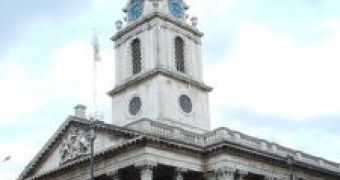Archaeologists have found a rare Roman limestone sarcophagus containing a headless skeleton during excavations at St-Martin-in-the-Fields Church, central London.
The sarcophagus discovered near Trafalgar Square could redraw the map of Roman London. The coffin dates to around 410 A.D. and lay 10 feet below the grounds, outside the boundaries researchers had established for London's Roman city walls. Researchers previously believed Westminster possibly contained Roman roads but not sacred buildings. "The find has opened up an exciting new area of Roman London for study," said Taryn Nixon, director of the Museum of London Archaeology Service. "It means that perhaps St-Martin-in-the-Fields has been a sacred site for far, far, far longer than we previously thought."
"This gives us an extraordinary glimpse of parts of London we haven't seen before, particularly Roman London and Saxon London. All of a sudden we're having to rethink what Roman London really was. This work has literally stopped us in our tracks and given us a new phrase, Roman Westminster."
"I can't tell you how thrilling it is to have discovered these finds." said Vicar Rev Nicholas Holtam. "St Martin's history tells us that the earliest church that we know of on the site was there in 1222, but these discoveries take us way before that."
"It's certainly a sacred site, possibly a Christian site, going right back into the late Roman period."
The coffin was made from a single piece of limestone from Oxfordshire or Northamptonshire, about 60 miles (100 km) northwest of London. The skeleton, headless and with missing fingers, belongs to a 5-foot-6-inch (1.75 cm) male who died in his 40s. Researchers think that the skull was taken by Victorian workmen building a sewer.
24 medieval burial sites were discovered in the area above and around the Roman coffin during work on the church grounds this summer. "The site is about a mile west of the boundary of Roman London established by researchers", said Roman history expert Hedley Swain.
Two similar finds were made in London during the 1970s and once at Westminster Abbey during the 19th century.

 14 DAY TRIAL //
14 DAY TRIAL //